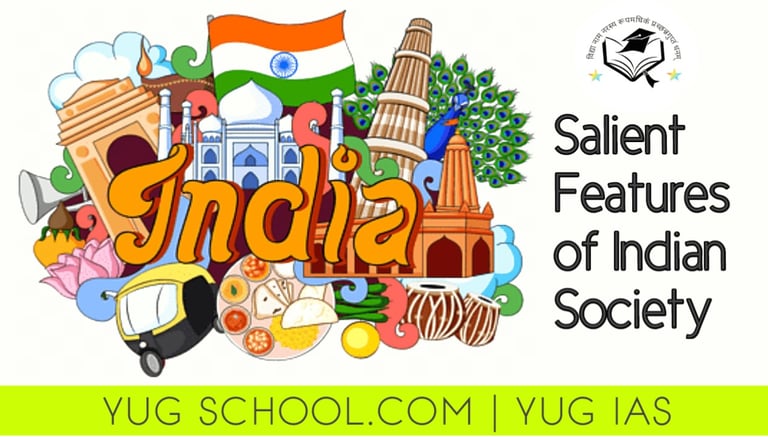Salient Features of Indian Society
India's society is a vibrant tapestry woven from diverse threads of ethnicity, language, religion, and social structures. Understanding its salient features requires acknowledging both its rich complexities and unique characteristics. Here are some key aspects to consider
GENERAL STUDIES 1


India's society is a vibrant Nation-state woven from diverse threads of ethnicity, language, religion, and social structures. Understanding its salient features requires acknowledging both its rich complexities and unique characteristics. Here are some key aspects to consider:
Diversity:
Multi-ethnic: Home to countless ethnic groups, each with distinct customs and traditions.
Multilingual: Over 22 official languages and hundreds of dialects paint a linguistic landscape of remarkable variety.
Multi-religious: Hinduism, Islam, Christianity, Sikhism, Buddhism, Jainism, and numerous other faiths coexist, fostering a spirit of tolerance and cultural exchange.
Multi-caste: While the hierarchical caste system is officially abolished, its social and economic influences persist, demanding ongoing efforts towards equality.
Social Structures:
Family-centric: The family unit holds immense importance, providing emotional and financial support through generations. Joint families, though declining, remain prevalent in many regions.
Kinship systems: Strong kinship bonds extend beyond immediate family, creating a wider network of social support and obligation.
Village communities: Traditionally, rural life centered around close-knit village communities with shared customs and governance structures. While urbanization is rising, these communities retain their significance.
Tribal societies: India boasts a rich tribal heritage with unique customs, languages, and ways of life. Recognizing and protecting their rights is crucial.
Values and Beliefs:
Spiritualism: A strong emphasis on spiritual values permeates various religions and philosophies, shaping perspectives on life and death.
Balance between individualism and collectivism: While individual aspirations are increasingly valued, a sense of community and collective responsibility remains strong.
Traditionalism and modernity: A dynamic interplay between age-old practices and contemporary influences shapes social norms and individual choices.
Unity in Diversity:
Despite its inherent diversity, India strives for unity through shared values like democracy, secularism, and respect for diversity. However, achieving social harmony and addressing inequalities remain ongoing challenges.
It's important to remember that these are just broad strokes, and the nuances of Indian society vary greatly depending on region, religion, caste, and individual experiences. Engaging with diverse perspectives and recognizing the dynamism of this society are crucial for a deeper understanding.
1. Multi-ethnic Society: India is a diverse and multi-ethnic society characterized by a range of different languages, religions, and cultural practices. Ethnic groups include Indo-Aryans, Dravidians, Mongoloids, tribals, and others. These diverse backgrounds contribute to the rich tapestry of Indian culture.
2. Multilingualism: India is home to many native languages, and it is also common for people to be bilingual or multilingual. The linguistic diversity reflects the country's vastness and regional variations.
3. Multi-religious Society: Religion is deeply ingrained in Indian society. Major religions like Hinduism, Islam, Buddhism, Sikhism, Jainism, and Christianity coexist harmoniously. India's secular government ensures equal rights and freedom of religion for all citizens.
4. Caste System: Historically, Indian society has been characterized by a strict social hierarchy based on caste. While efforts have been made to address this inequality, remnants of the caste system still persist.
5. Unity in Diversity: Despite its diversity, India maintains a sense of unity through shared cultural values and a common identity as Indians.
6. Patriarchal Society: Traditional gender roles often place men in dominant positions within families and communities.
7. Tribes: Indigenous tribal communities exist across India, preserving their unique cultures and ways of life.
8. Family and Kinship System: Families play a central role in Indian society, providing emotional and financial support.
9. Balance Between Spiritualism and Materialism: India's spiritual heritage coexists with modern materialistic aspirations.
10. Balance Between Individualism and Collectivism: While individual rights are valued, collective well-being remains important.
11. Coexistence of Traditionalism and Modernity: India seamlessly blends ancient traditions with modern advancements.
In summary, Indian society is multifaceted, encompass
In a nutshell
